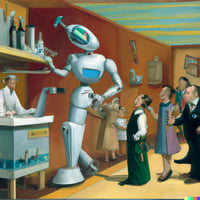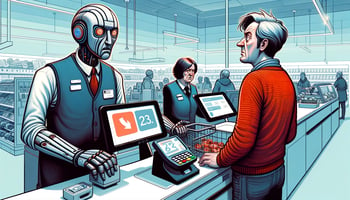The Symbiosis of AI and CX Welcome to a future where Artificial Intelligence (AI) is essential in...
The 5 Leadership Habits That Drive Great Customer Experience

Customer experience (CX) has become the battlefield where brands win or lose loyalty. Technology, product range, and pricing all matter, but it is leaders who set the tone for how customers truly feel when they interact with your organisation.
Excellent customer experience (CX) is seldom the result of a single grand strategy. More often, it stems from the daily habits of leaders that influence their teams. These habits shape culture, affect behaviours, and ultimately decide whether customers leave as advocates or critics.
Here are five leadership habits that consistently improve great customer experience, alongside real examples of how they make a difference.
1. Listening First – to Customers and Colleagues
Leaders who prioritise listening over talking uncover valuable insights. Customers often give feedback subtly: a hesitation at checkout, a question that shows confusion, or a tone of frustration on the phone. Frontline colleagues notice these cues daily, but unless leaders make listening a habit, these insights never reach decision-making tables.
Consider the example of a UK high street bank. A regional manager started hosting weekly “customer story huddles” where branch staff shared one positive and one negative customer interaction. Over a few months, trends appeared – customers were frustrated by complicated online forms and felt pushed back into branches for simple tasks. This insight was shared with the head office and led to a redesign of digital onboarding. The outcome: fewer complaints, increased digital adoption, and happier staff who felt listened to.
The habit: Make listening an essential part of your leadership rhythm. Whether it’s walking the shop floor, joining call reviews, or holding listening sessions, leaders who listen better lead more effectively.
2. Walking in the Customer’s Shoes
The best leaders don’t just discuss customer journeys; they live them. Habitually putting themselves in the customer’s position – ordering online, handling returns, calling the helpline – uncovers gaps that spreadsheets and dashboards can’t reveal.
One retail CEO we recently worked with made a point of shopping in her own stores incognito every month. On one occasion, she queued for 15 minutes at the tills while staff struggled with a new payment system. Instead of blaming, she used the experience to advocate for more training and a system upgrade. The message to staff was clear: “I understand what our customers go through – and I’ll act on it.”
The habit: Make time to act as your own customer. Keep it straightforward, do it regularly, and apply what you learn to improve the business.
3. Recognising and Rewarding Everyday Customer Experience Wins
Customer experience isn’t shaped by big campaigns alone. It’s built through small acts – the cashier who remembers a regular’s name, the call centre agent who takes time to explain, the delivery driver who goes the extra mile. Leaders who consistently recognise and celebrate these acts inspire others to do the same.
At a department store in Ireland, a store manager began writing short, handwritten thank-you notes to staff whenever customers complimented them. The notes were pinned on the staff noticeboard. It cost nothing but sparked a ripple of pride and motivation. Colleagues started to look for ways to “earn a note”. Over time, customer compliments increased, and the habit spread to other stores.
The habit: Recognition doesn’t need to be elaborate or costly. Make it frequent, genuine, and visible.
4. Balancing Metrics and Moments
Leaders naturally focus on metrics – sales, NPS, queue times, conversion rates. But customers don’t experience life through metrics; they experience moments. Maintaining a balance between the two ensures that CX isn’t reduced to mere numbers.
Imagine a travel retailer facing pressure to cut queue times at airports. The data suggested adding more tills, but observations showed another reality: customers appreciated personal reassurance before making a big purchase. Instead of rushing transactions, leaders trained staff to spend a few extra seconds answering questions confidently. Queue times didn’t decrease as much as expected, but satisfaction scores rose significantly and sales conversion improved.
The habit: When reviewing performance, ask yourself not only “what do the numbers show?” but also “what do the moments feel like for our customers?”
5. Modelling the Behaviours You Expect
Culture is influenced less by slogans on the wall and more by what leaders do in daily practice. Leaders who consistently demonstrate the behaviours they wish to see – courtesy, patience, accountability – foster an environment where those behaviours flourish.
A well-known grocery chain in Ireland raised the standard for customer interaction: every customer should be greeted within 30 seconds of entering the store. Instead of issuing memos, the regional director made it his personal practice to greet every customer he encountered while visiting stores. Staff quickly realised this wasn’t a directive, but a way of working. Within weeks, mystery shopper scores for customer engagement improved significantly.
The habit: Your team observes what you do more than what you say. Ensure your actions mirror the CX culture you aim to establish.
The Leadership Habit Loop
Individually, these five habits may seem minor. However, collectively, they create a leadership habit cycle that consistently promotes a customer-centred culture.
- Listening ensures you understand the real issues.
- Walking in the customer’s shoes builds empathy and urgency.
- Recognition motivates staff to replicate good practice.
- Balancing metrics with moments keeps the customer perspective alive in boardrooms.
- Modelling behaviours ensures CX values stick.
Great customer experience isn’t an initiative or a programme. It’s the result of leaders choosing, day after day, to develop habits that influence others.
When leaders practise these habits consistently, the organisation not only talks about CX – it embodies it. And customers notice the difference.
Final thought: Habits are contagious. If you want a culture where great customer experience is the norm, start with your own daily routines. What you do as a leader will be reflected, amplified, and multiplied throughout your organisation.
At RetailCX, we specialise in helping organisations harness the power of leadership and employee engagement to enhance customer experiences. Contact us to learn how we can support your journey toward a more innovative and customer-centric future.




